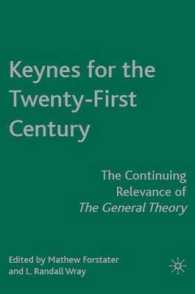- ホーム
- > 洋書
- > 英文書
- > History / World
Full Description
The current literature on consumerism is diverse, scattered, and unsystematic. This book remedies this by identifying the beginning of mass consumer society in the United States, starting with the New Deal. The New Deal framework of guaranteeing new home purchases by means of low down-payment, fixed-rate home mortgages lasted until the 1970s, at which time the legal framework unraveled due to a sustained attack on New Deal racism. Despite this, American consumerism continued and even flourished without a regulatory structure. This book analyzes seven key pieces of federal legislation which undergird American consumer society to this day.
Contents
Table of Contents
Preface
Introduction
Part One—The Regulatory Society
1. Democrats and Republicans Before 1932
2. Glass-Steagall as Foundational Legislation
3. Joe T. Robinson's Home Owners' Loan Act
4. The 1934 Housing Act and "Redlining"
5. Wagner-Steagall and Public Housing
6. Steagall-Wagner and the Creation of "Fannie Mae"
7. The 1945 Amended GI Bill and American Racism
8. African American Exodus and the 1949 Housing Act
9. Explosion! Levittowns and Shopping Malls
Part Two—The Deregulated Society
10. The White Working Class and the "Treaty of Detroit"
11. Brown, Civil Rights and the End of the New Deal
12. The 1970s: New Republicans and Old Democrats
13. Depository Institutions and the Flowering of Bain Capital
14. The Privatized Mortgage Industry of the 2000s
15. From Brooksley Born to Sarbanes-Oxley
16. Dodd-Frank and Legislative Approval of Consumer Society
Conclusions: The Consumer Paradise
Chapter Notes
Bibliography
Index








